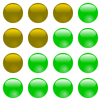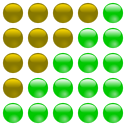Triangular number

A triangular number or triangle number counts the objects that can form an equilateral triangle, as in the diagram on the right. The nth triangular number is the number of dots composing a triangle with n dots on a side, and is equal to the sum of the n natural numbers from 1 to n. The sequence of triangular numbers (sequence A000217 in the OEIS), starting at the 0th triangular number, is
- 0, 1, 3, 6, 10, 15, 21, 28, 36, 45, 55, 66, 78, 91, 105, 120, 136, 153, 171, 190, 210, 231, 253, 276, 300, 325, 351, 378, 406 …
The triangle numbers are given by the following explicit formulas:
where is a binomial coefficient. It represents the number of distinct pairs that can be selected from n + 1 objects, and it is read aloud as "n plus one choose two".
Carl Friedrich Gauss is said to have found this relationship in his early youth, by multiplying n/2 pairs of numbers in the sum by the values of each pair n + 1.[1] However, regardless of the truth of this story, Gauss was not the first to discover this formula, and some find it likely that its origin goes back to the Pythagoreans 5th century BC.[2] The two formulae were described by the Irish monk Dicuil in about 816 in his Computus.[3]
The triangular number Tn solves the "handshake problem" of counting the number of handshakes if each person in a room with n + 1 people shakes hands once with each person. In other words, the solution to the handshake problem of n people is Tn−1.[4] The function T is the additive analog of the factorial function, which is the products of integers from 1 to n.
The number of line segments between closest pairs of dots in the triangle can be represented in terms of the number of dots or with a recurrence relation:
In the limit, the ratio between the two numbers, dots and line segments is
Relations to other figurate numbers
Triangular numbers have a wide variety of relations to other figurate numbers.
Most simply, the sum of two consecutive triangular numbers is a square number, with the sum being the square of the difference between the two (and thus the difference of the two being the square root of the sum). Algebraically,
Alternatively, the same fact can be demonstrated graphically:
| 6 + 10 = 16 |  |
10 + 15 = 25 |  |
There are infinitely many triangular numbers that are also square numbers; e.g., 1, 36, 1225. Some of them can be generated by a simple recursive formula:
- with
All square triangular numbers are found from the recursion
- with and

Also, the square of the nth triangular number is the same as the sum of the cubes of the integers 1 to n. This can also be expressed as
The sum of the all triangular numbers up to the nth triangular number is the nth tetrahedral number,
More generally, the difference between the nth m-gonal number and the nth (m + 1)-gonal number is the (n − 1)th triangular number. For example, the sixth heptagonal number (81) minus the sixth hexagonal number (66) equals the fifth triangular number, 15. Every other triangular number is a hexagonal number. Knowing the triangular numbers, one can reckon any centered polygonal number; the nth centered k-gonal number is obtained by the formula
where T is a triangular number.
The positive difference of two triangular numbers is a trapezoidal number.
Other properties
Triangular numbers correspond to the first-degree case of Faulhaber's formula.
Alternating triangular numbers (1, 6, 15, 28, ...) are also hexagonal numbers.
Every even perfect number is triangular (as well as hexagonal), given by the formula
where Mp is a Mersenne prime. No odd perfect numbers are known, hence all known perfect numbers are triangular.
For example, the third triangular number is (3 × 2 =) 6, the seventh is (7 × 4 =) 28, the 31st is (31 × 16 =) 496, and the 127th is (127 × 64 =) 8128.
In base 10, the digital root of a nonzero triangular number is always 1, 3, 6, or 9. Hence every triangular number is either divisible by three or has a remainder of 1 when divided by nine:
- 0 = 9 × 0
- 1 = 9 × 0 + 1
- 3 = 9 × 0 + 3
- 6 = 9 × 0 + 6
- 10 = 9 × 1 + 1
- 15 = 9 × 1 + 6
- 21 = 9 × 2 + 3
- 28 = 9 × 3 + 1
- 36 = 9 × 4
- 45 = 9 × 5
- 55 = 9 × 6 + 1
- 66 = 9 × 7 + 3
- 78 = 9 × 8 + 6
- 91 = 9 × 10 + 1
- …
The digital root pattern for triangular numbers, repeating every nine terms, as shown above, is "1, 3, 6, 1, 6, 3, 1, 9, 9".
The converse of the statement above is, however, not always true. For example, the digital root of 12, which is not a triangular number, is 3 and divisible by three.
If x is a triangular number, then ax + b is also a triangular number, given a is an odd square and b = a − 1/8
Note that b will always be a triangular number, because 8Tn + 1 = (2n + 1)2, which yields all the odd squares are revealed by multiplying a triangular number by 8 and adding 1, and the process for b given a is an odd square is the inverse of this operation.
The first several pairs of this form (not counting 1x + 0) are: 9x + 1, 25x + 3, 49x + 6, 81x + 10, 121x + 15, 169x + 21, … etc. Given x is equal to Tn, these formulas yield T3n + 1, T5n + 2, T7n + 3, T9n + 4, and so on.
The sum of the reciprocals of all the nonzero triangular numbers is
This can be shown by using the basic sum of a telescoping series:
Two other interesting formulas regarding triangular numbers are
and
both of which can easily be established either by looking at dot patterns (see above) or with some simple algebra.
In 1796, German mathematician and scientist Carl Friedrich Gauss discovered that every positive integer is representable as a sum of three triangular numbers (possibly including T0 = 0), writing in his diary his famous words, "EΥΡHKA! num = Δ + Δ + Δ". Note that this theorem does not imply that the triangular numbers are different (as in the case of 20 = 10 + 10 + 0), nor that a solution with exactly three nonzero triangular numbers must exist. This is a special case of Fermat's Polygonal Number Theorem.
The largest triangular number of the form 2k − 1 is 4095 (see Ramanujan–Nagell equation).
Wacław Franciszek Sierpiński posed the question as to the existence of four distinct triangular numbers in geometric progression. It was conjectured by Polish mathematician Kazimierz Szymiczek to be impossible. This conjecture was proven by Fang and Chen in 2007.[5][6]
Applications
A fully connected network of n computing devices requires the presence of Tn − 1 cables or other connections; this is equivalent to the handshake problem mentioned above.
In a tournament format that uses a round-robin group stage, the number of matches that need to be played between n teams is equal to the triangular number Tn − 1. For example, a group stage with 4 teams requires 6 matches, and a group stage with 8 teams requires 28 matches. This is also equivalent to the handshake problem and fully connected network problems.
One way of calculating the depreciation of an asset is the sum-of-years' digits method, which involves finding Tn, where n is the length in years of the asset's useful life. Each year, the item loses (b − s) × n − y/Tn, where b is the item's beginning value (in units of currency), s is its final salvage value, n is the total number of years the item is usable, and y the current year in the depreciation schedule. Under this method, an item with a usable life of n = 4 years would lose 4/10 of its "losable" value in the first year, 3/10 in the second, 2/10 in the third, and 1/10 in the fourth, accumulating a total depreciation of 10/10 (the whole) of the losable value.
Triangular roots and tests for triangular numbers
By analogy with the square root of x, one can define the (positive) triangular root of x as the number n such that Tn = x:[7]
which follows immediately from the quadratic formula. So an integer x is triangular if and only if 8x + 1 is a square. Equivalently, if the positive triangular root n of x is an integer, then x is the nth triangular number.[7]
See also
References
- ↑ Hayes, Brian. "Gauss's Day of Reckoning". American Scientist. Computing Science. Retrieved 2014-04-16.
- ↑ Eves, Howard. "Webpage cites AN INTRODUCTION TO THE HISTORY OF MATHEMATICS". Mathcentral. Retrieved 28 March 2015.
- ↑ Esposito,M. An unpublished astronomical treatise by the Irish monk Dicuil. Proceedings of the Royal Irish Academy, XXXVI C. Dublin, 1907, 378-446.
- ↑ http://www.mathcircles.org/node/835
- ↑ Chen, Fang: Triangular numbers in geometric progression
- ↑ Fang: Nonexistence of a geometric progression that contains four triangular numbers
- 1 2 Euler, Leonhard; Lagrange, Joseph Louis (1810), Elements of Algebra, 1 (2nd ed.), J. Johnson and Co., pp. 332–335
External links
| Wikimedia Commons has media related to triangular numbers. |
- Hazewinkel, Michiel, ed. (2001), "Arithmetic series", Encyclopedia of Mathematics, Springer, ISBN 978-1-55608-010-4
- Triangular numbers at cut-the-knot
- There exist triangular numbers that are also square at cut-the-knot
- Weisstein, Eric W. "Triangular Number". MathWorld.
- Hypertetrahedral Polytopic Roots by Rob Hubbard, including the generalisation to triangular cube roots, some higher dimensions, and some approximate formulae

